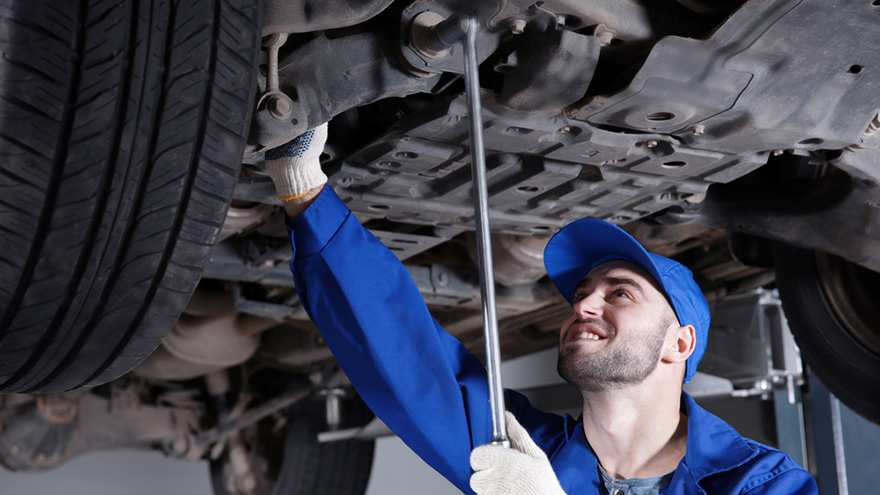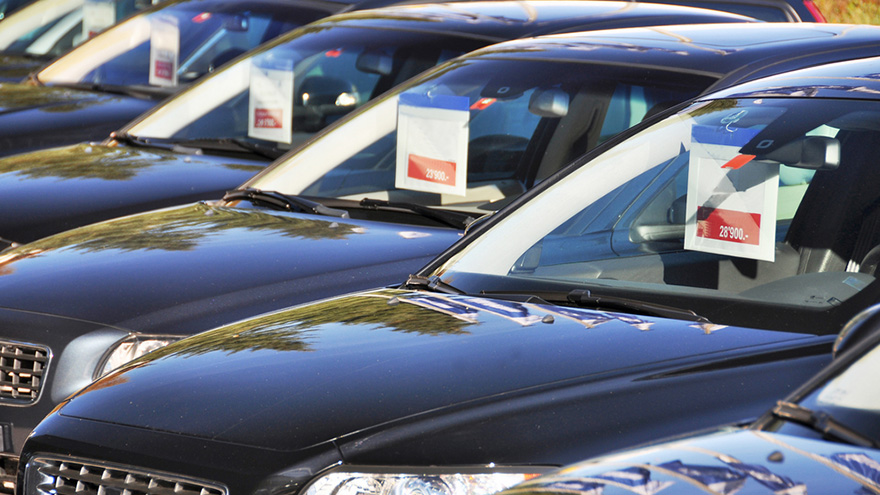Based on sales data for the first six months of each calendar year dating back to 2013, franchised dealerships are retailing more used vehicles this year than ever.
The National Automobile Dealers Association shared that sales trend on Wednesday afternoon as a part of its midyear version of NADA Data 2019, a biannual financial profile of America’s franchised dealerships highlighting major milestones in the retail automotive industry.
The report indicated franchised dealers retailed 7.89 million units during the first six months of this year. That’s up from 7.55 million used sales during the first half of 2018.
The used-vehicle sales pace franchised dealers currently are traveling is much higher than what NADA recorded earlier this decade. Here is the rundown of sales figures at the year’s midpoint:
2019: 7.89 million
2018: 7.55 million
2017: 6.91 million
2016: 7.00 million
2015: 6.76 million
2014: 6.71 million
2013: 6.65 million
The report — that’s available for download here — also showed the average retail price of those used vehicles being turned at franchised stores is on the rise, too. Halfway through 2019, that average retail price stood at $20,835.
Here is the rundown of those readings:
2019: $20,835
2018: $20,390
2017: $19,970
2016: $19,880
2015: $19,240
2014: $18,700
2013: $17,930
What typically happens within the confines of a dealership — retailing and servicing vehicles — isn’t solely influencing the values and transactions of stores nowadays. Rather, two firms that monitor dealership buy/sell activities mentioned other factors such as foreign-trade clashes as an element that could impact if activity picks up significant steam to close the year.
Haig Partners and Kerrigan Advisors each recently shared their second-quarter reports, discussing an array of economic factors that might play a role in what a single-point, family-owned store might fetch, as well as how dealer groups might expand their footprints.
“Auto dealers have managed to defy gravity and increase their profits compared to last year,” Haig Partners president Alan Haig said in a news release. “The buy-sell market has suffered this year due to uncertainties in buyers’ minds about tariffs and the overall direction of the economy.
“But the ongoing strength of the auto-retail industry is bringing buyers back to the table, and we believe that transaction activity will rebound to more normal levels in the second half of the year,” Haig continued. “Given the large number of dealerships available for purchase, we think the rest of 2019 and 2020 will present excellent opportunities for groups looking to add scale.”
Despite recession fears, Kerrigan Advisors also expects dealership buy/sell activity to remain strong for the remainder of 2019.
“The global trade war has clearly caused uncertainty in the investment community, leading to a flight to higher quality, less risky assets,” said Erin Kerrigan, founder and managing director of Kerrigan Advisors. “Auto retail is emerging as one of those asset classes.
“High net worth individuals, family offices and Wall Street investors recognize the counter cyclical measures dealers can take to sustain profitability, even when new car sales turn south,” Kerrigan continued in a news release. “Auto retail’s nimble model makes the industry a highly attractive investment in a time of greater economic uncertainty.”
More details from Haig
As published in the Q2 2019 edition of The Haig Report, the number of dealerships bought and sold in the U.S. decreased by 60% in Q2, compared to an exceptionally busy Q2 2018. The number of dealerships that traded hands fell from 122 to 49.
Haig pointed out acquisition spending in the first two quarters of 2019 by publicly traded auto retailers is less than half of that spent in the same period of 2018. The firm explained this pause in public company investments may be attributed to waiting to see the outcome of trade wars, tariffs and Federal Reserve actions unfolding.
Thanks to a lift in dealership profits so far this year, Haig noted the estimated average blue-sky value per dealership held steady from 2018. At current multiples, dealerships offer a healthy return to buyers and strong prices to sellers.
“There are a large number of dealerships on the market for sale today due to aging owners, increasing complexity of operations, and a perception that smaller dealers will have greater difficulties competing with larger groups in the future,” the firm said.
Other key findings from the Q2 2019 Haig Report include:
• Macroeconomic indicators such as GDP, employment and household incomes, transaction size, low fuel prices and consumer sentiment remain highly favorable for dealers.
• Private dealers are increasing their focus on used vehicles, with volume up 4.1% compared to last year and several clients achieving greater than 2:1 used to new ratio.
• On a combined basis profits have trended upward as the gains in Parts & Service and Finance & Insurance have more than offset the declines in the new car business.
• Floorplan expense has driven almost all of the increase in cost, with a $275 swing in net floorplan cost over the last 3 ½ years. However, the Federal Reserve’s recent 25 basis point rate cut should lead to a $25 lower floorplan expense per vehicle retailed for the average dealer.
• The NADA average private dealership profits for the 12-month period ended Q2 2019 was $1.37M, up 0.6%, reversing three years of declines.
• Most investors now believe autonomous vehicles are unlikely to impact dealers for decades and electric vehicles will remain a niche market.
To download The Haig Report, go to this website.
Additional insights from Kerrigan
Kerrigan Advisors reported this year’s dealership buy/sell market stayed steady and on course for yet another year of more than 200 transactions with 103 completed transactions year-to-date.
According to the just-released Second Quarter 2019 Blue Sky Report by Kerrigan Advisors, a decline in new vehicle sales spurred dealers to turn to their higher margin business segments, resulting in an increase in gross profit and earnings.
“The buy/sell market moved at a slower pace during the second quarter,” Erin Kerrigan said. “Yet even with the second quarter’s decline, 2019 is tracking to be another 200+ transaction year — the sixth consecutive year at this elevated level. Kerrigan Advisors expects transaction activity to remain at today’s elevated pace through the remainder of 2019 and into 2020.”
Kerrigan noted that since 2014, an estimated 1,000 dealers have sold their businesses, representing 12% of the total dealer network. The firm said sellers continue to come to market at a high rate, while the buyer pool grows with new capital seeking investment in auto retail thanks to a diversified and high-margin business model that hedges against an uncertain economy.
This year’s earnings increase, forecasted in Kerrigan Advisors’ prior Blue Sky Reports, highlighted the strength and sustainability of the auto retail business model. Kerrigan mentioned the continued shift to higher margin profit centers such as used-vehicle sales, F&I, and fixed operations also reflects the reported record earnings in the second quarter by public dealer groups. In their quarterly earnings calls, the groups noted their continued success augmenting new vehicle gross profits with record F&I income per vehicle sold.
According to the report, in the first half of the year the number of multi-dealership transactions also declined. The rise in single dealership transactions may reflect “franchise pruning” that many organizations are currently undertaking.
“Both the public groups and large private dealership groups are capitalizing on their ability to jettison underperforming dealerships and redeploy their capital into higher ROI investments in today’s active buy/sell market,” said Ryan Kerrigan, managing director of Kerrigan Advisors. “Among the franchises being acquired, domestics continue to grow their market share because buyers are attracted to their lower blue-sky multiples and higher expected ROI.”
In addition, the report identified the following three trends, which are expected to meaningfully impact the buy/sell market through the remainder of 2019 and into 2020. They included:
— Improvement in dealership earnings steadies blue sky values
— Publics’ stock price appreciation portends future acquisitions
— Lower interest rates support an active buy/sell market
Other highlights from Kerrigan Advisors’ latest report included:
— The buy/sell market moved at a slower pace in the second quarter, with 49 transactions completed.
— The Kerrigan Index is up 37.1% through July. Wall Street investors increasingly believe an auto retail investment is a hedge against a potential recession.
— Average dealership earnings increased 1% over the trailing twelve months ending in June 2019, the first increase in dealership earnings since 2015.
— Despite a decline in new-vehicle sales, dealers grew their higher margin business segments, resulting in an increase in gross profit and earnings.
— Since 2014, fixed operations and used vehicle gross profits have increased 10.8% and 27.6%, respectively. By contrast, new-vehicle gross profits have declined 7.6%.
— Today, fixed operations and used vehicles represent 75.9% of the average dealer’s gross profit, while new vehicles represent just 24.1% of gross profits.
— Domestics continue to increase their share of the buy/sell market at the expense of import non-luxury and import luxury franchises, which both saw their buy/sell market share decline to 22% and 9% respectively in the first half of 2019, the lowest level in five years.
— Rising real estate prices are increasing the total enterprise value of dealerships and more than offsetting any decline in blue sky value.
Kerrigan Advisors also downgraded Nissan and Infiniti high-end multiples as the OEM prioritizes volume over dealer profitability and maintains punitive stair step programs that distort vehicle pricing, creating earnings volatility within the dealer network.
For more details and to preview Kerrigan Advisors report, go to this website.
Along with finalizing its lineup of keynote speakers for NADA Show 2020, the National Automobile Dealers Association is making its award-winning educational training programs more readily accessible to members and their staffs.
NADA said its training offers, such as the Professional Series classes and Academy seminars, are now available to all dealership employees through the new Education Subscription program.
“The subscription to NADA’s educational training programs is a powerful tool for providing continuous training and development to dealership employees at a low-cost monthly subscription,” said NADA chairman Charlie Gilchrist, a multi-franchise dealer in the Dallas-Fort Worth area of Texas.
The subscription can be secured here.
NADA and Reflection Software recently won a gold award from the Brandon Hall Group for excellence in the category of Best Use of Video for Learning.
The award-winning training video module, “Finding Meaning Behind the Words: How Video Scenarios Brought the DISC Model to Life for Dealerships,” is part of NADA’s Professional Series course in Leadership, which centered on teaching how to effectively utilize the DISC Behavioral Model when interacting with colleagues and customers.
Reflection Software, which offers custom-built training and career development products, created the video module to supplement NADA’s instructor-led training classes.
“We are developing industry-leading curriculum for our members, and it’s satisfying when it is recognized beyond the auto industry by an organization as established as the Brandon Hall Group,” NADA executive vice president and chief operating officer Mike Stanton said in a news release.
NADA and Reflection Software worked together to develop the video module, which included real-life video scenarios with interactive decision points to enhance the learning experience through observation and action. The video scenarios created for the module were designed to be authentic to the dealership setting.
Brandon Hall Group Excellence Awards Program has recognized leading organizations during the past 20 years for the latest trends in Human Capital Management, according to Rachel Cooke, Brandon Hall Group COO and leader of the HCM Excellence Awards Program.
“The initiatives that were honored are not only innovative but fit the unique needs of the business and create truly remarkable success stories,” Cooke said.
Brandon Hall Group is an HCM research and advisory services firm that provides insights on key performance areas, including learning and development, HR/workforce management, leadership development and more.
Award entries, which were evaluated by a panel of independent industry experts and Brandon Hall Group analysts and executives, were based on the following criteria:
— Fit the need
— Design of the program
— Functionality
— Innovation
— Overall measurable benefits
Lineup for NADA Show 2020
Each year, the NADA Show brings world-renowned speakers and industry experts to its four-day event to share insights on topics that will help drive dealerships into the future. The keynote speakers for NADA Show 2020 include David Cameron, former prime minister of the United Kingdom from 2010 to 2016, and Mary Barra, chairman and chief executive officer of General Motors.
Gilchrist, the 2019 NADA chairman, and Rhett Ricart, 2019 NADA vice chairman, will share their perspectives on the auto industry. Kathleen Madigan, voted best female stand-up at the American Comedy Awards, will offer comedic relief.
NADA’s annual show returns to Las Vegas for Valentine’s Day weekend from Feb. 14-17.
Attendee registration for the show is open here. The early-bird registration discount ends Sept. 13. NADA said the popular hotels are selling out.
The shortage of trained auto mechanics has been the subject of many news articles. Matrix Trade Institute’s 20-week accelerated auto mechanic training program is working to ease that shortage.
Noting the great demand for auto mechanics as many mechanics approach retirement and not enough prospective mechanics are looking to enter the profession, Matrix Trade Institute says it has trained more than 80 mechanics in northeast Ohio since it started out at the beginning of this year.
Matrix Trade Institute co-founder Dustin Peugeot says his company works toward “igniting careers.”
“If you want to learn the trade, we can get you there faster and more efficiently with interactive learning technology and hands-on skill and efficiency training,” Peugeot said in a news release.
The institute also trains local dealerships and auto repair shops in increasing their workforce’s efficiency. Matrix says its Upskill Efficiency Bootcamps helps dealerships and shops improve retention and recruiting efforts.
Matrix says it uses “upskilling” and efficiency training to help boost productivity, wages, and growth opportunities. The institute says it has helped “progressive organizations” such as Penske, Conrad’s, and Sunnyside.
Peugeot said shops that use “focused, off-site, hands-on education” to retain employees “never has a recruitment problem.”
“That’s what we're designed for,” Peugeot added. “We’re the lever businesses need to be better than the competition, produce more today, and prepare for tomorrow as the talent gap widens.”
Manheim says that its introduction on Wednesday of personalized vehicle suggestions within its Manheim Market Report valuation tool means time savings for dealers, who will see “highly relevant and immediately available inventory” on a page that they use daily.
Manheim says that dealers are seeing more of a need to use smart technology in making the best buying and selling decisions during a time of what it describes as “growing margin compression and uncertainty in the market.” The company is introducing the personalized vehicle inventory to help dealers accomplish this.
M LOGIC, a Manheim group of advanced decisioning products that the company launched earlier this year to bring Cox Automotive data to the remarketing industry, drives the suggestions.
Manheim says tens of thousands of dealers use the Manheim Market Report each year as a source of wholesale vehicle values to research which vehicles to buy and how much to pay for them. When dealers seek MMR valuations for a given vehicle, they will see — in a carousel-style format — up to 12 similar vehicles available for sale.
To access detailed information about the vehicle, dealers can click on a specific similar vehicle. Or, they can choose to view additional similar vehicles for sale within the Manheim Marketplace. Manheim says that by using those features, dealers can find and compare relevant vehicles quickly. That allows them to make more informed buying and selling decisions, Manheim said.
Using millions of vehicle transactions, along with vehicle data, MMR values vehicles given their specific mileage, condition, exterior color and region. The digital site displays the base MMR and adjusted MMR values and also includes AutoCheck and Carfax quick links. Manheim said that places important decision-making information at clients’ fingertips, on mobile and desktop channels.
The company says the addition of M LOGIC suggested inventory to MMR “raises the bar in wholesale valuation tools.” According to the company, it gives Manheim’s clients an edge in bringing success to their businesses.
“Personalized vehicle inventory is our latest innovation from the M LOGIC suite of decisioning products and is live today for all MMR users,” M LOGIC associate vice president Ben Flusberg said in a news release.
Flusberg added, “Our MMR digital site receives 75 million valuation requests each year, so we know it’s a tool that dealers regularly use to complete their research. At the same time, a common theme we hear from dealers is that it’s hard to find the right inventory, especially within digital channels.”
He also noted, “By presenting relevant vehicles at the moment dealers are doing their research on MMR, we're bringing the right inventory to them at the right time. It's part of Manheim’s commitment to continually help its clients become more efficient and profitable. And based on the strong digital engagement we've seen so far, we know this new feature is really helping them."
As a wholesale vehicle valuations tool, MMR uses millions of vehicle transactions and vehicle data to value vehicles given their specific mileage, condition, exterior color and region, according to Manheim. The digital site displays the base MMR and adjusted MMR values and also includes AutoCheck and Carfax quick links. That, according to Manheim, places important decision-making information at clients’ fingertips over mobile and desktop channels.
Dealers will experience this new functionality by logging into Manheim Market Report and using their Manheim credentials.
It’s the activity certain customers dread and dealerships sometimes can struggle to handle appropriately without possibly upsetting the potential buyer who could move on to a competitor.
MAX Digital recently launched MAX My Trade, a guided experience that’s designed to improve the trade-in process for dealership teams and their customers.
Typically conducted on an iPad, the digital retail software provider explained the customer and dealership salesperson walk around the vehicle appraising the unit together. With the walkaround app, the customer and salesperson can choose a mutually agreed upon rating on a 10-point scale for different aspects of the car, such as interior condition, brakes, and tires.
After the walkaround evaluation, a market-based appraisal report will provide a fair market price combining the customer’s vehicle condition rating score with top book values of third-party validation sites such as Kelley Blue Book and NADA. Customer ratings naturally drive lower valuations creating a positive environment for under-allowance.
The final trade offer is approved by the sales manager so the dealership retains control, according to MAX Digital executive vice president Mike Cavanaugh.
“When you get customers involved in the appraisal process, they feel more in control, understand the fair value of their vehicle, and overall feel a lot better about the sales process,” Cavanaugh said in a news release.
“Our dealer customers who have beta-tested MAX My Trade have seen this firsthand with an average 47% increase in front-end gross profits and improved CSI,” Cavanaugh continued.
MAX My Trade also includes an at-a-glance profitability reporting tool, which can provide dealerships a comparison of appraisals submitted both with and without the tool. Dealers can easily monitor sales, team usage and results to uncover opportunities to further grow profits.
“When we get the customer interacting in the trade, all the armor comes off. They feel very powerful that they are actually appraising the vehicle themselves,” said Brad DeSelms, sales director for Fremont Management Co.
“The more you involve the customer in the trade-in process, the more they see the logic in how you price the car and the more money you make,” DeSelms continued.
Vancouver Toyota used car manager Lee Porter added, “One of the immediate benefits is the involvement of the customer in the appraisal process. That involvement is translating into a 5% higher closing rate.
“The change has also reduced the time needed to complete the sales process, resulting in our CSI increasing to 96.74%,” Porter went on to say.
For more information about MAX My Trade, visit this website.
If Hyundai dealership customers cannot stay in the plush waiting area while their vehicles are being serviced, store managers now have another option to keep their patrons satisfied.
In the next several months, Hyundai dealers across the country that subscribe to Hailer service through CDK Global can give owners easy access to Lyft rides while their vehicles are being serviced.
Through Hailer, an application developed by CDK in partnership with Lyft, participating Hyundai dealers that subscribe to Hailer service through CDK can now help eliminate transportation barriers by providing Lyft rides for customers, which can either be offered free of charge or at a cost that can be automatically added to the customer’s service bill for seamless payment at each individual dealership’s discretion.
The companies explained these Lyft rides can help address significant customer hurdles around transportation while a vehicle is being serviced or inspected, minimizing time spent waiting at the dealership. Previously, service customers could take the dealer-offered shuttle or loaner vehicle, wait for their car to be serviced or find their own transportation to and from the dealership. Hailer has the opportunity to increase customer satisfaction through a decline in wait times, which reflects an industry shift that has the potential to improve customer experience and business efficiency.
“Hailer provides dealerships with greater efficiencies,” said Mahesh Shah, executive vice president, chief product and technology officer at CDK Global.
“We are excited that Hyundai is providing its customers with Lyft convenience at participating dealerships with CDK Drive, while affording its dealers seamless backend integration. We look forward to enabling improved customer experiences through this comprehensive dealer solution,” Shah continued.
As an example, a Hyundai customer calls their service adviser to schedule an appointment at a participating dealership. At the dealership, the service adviser offers a Lyft ride after writing up the work order. The Lyft ride arrives a few minutes later to take the customer to work, and when the work is complete, the service adviser arranges another Lyft ride back to the dealership. The customer gets a text message through Hailer when the Lyft ride is in route, and the rides are automatically added to the customer’s service bill by the dealership. The process is simple for customers and does not require that they have the Lyft app on their smartphone to order rides.
The companies also mentioned the integration is also easy for participating Hyundai dealers because it allows them to automate billing, set ride spending limits and approve service. The improved Hailer experience can simplify a dealership’s service to customers and ultimately reduces the number of customers waiting in service lounges.
“Our customers are going to really like the convenience of Lyft,” said Barry Ratzlaff, vice president of customer satisfaction, Hyundai Motor America. “Hyundai dealers who are already using Hailer have reported a smooth integration allowing them to call Lyft rides for their customers.
“Customers can now easily get on with their day while the inspection or service work is being performed on their car,” Ratzlaff continued.
Gyre Renwick, vice president, Lyft Business, added, “At Lyft, we’re passionate about providing transportation experiences that enhance customer satisfaction and create a streamlined, more cost-efficient solution for our business partners.
“Hailer has the potential to disrupt and evolve the auto dealership industry, and we’re excited to partner with Hyundai to introduce this solution at scale for participating dealerships across the country,” Renwick went on to say.
New-vehicle sales might be softening so far this year, but franchised dealerships themselves are turning at a significant pace.
Kerrigan Advisors reported that this year’s dealership buy/sell market rocketed to a strong start in Q1 with 54 completed transactions, representing a 38.5% increase year-over-year. Analysts said in the First Quarter 2019 Blue Sky Report that the first-quarter pace indicates that 2019 is on track to be the sixth consecutive year of 200 transactions or more.
In spite of a 3.2% new-vehicle sales decline, Kerrigan Advisors founder and managing director Erin Kerrigan noted that continued profit stability and an increase in sellers coming to market is contributing to the robust outlook for the buy/sell market.
“As Kerrigan Advisors predicted, 2019 is shaping up to be another solid year for buy/sells and valuations,” Kerrigan said in a news release. “In the face of a decline in new-vehicle sales, the diversity of the dealership business model continues to demonstrate its value through its ability to sustain profits.
“In addition, the influx of older generation sellers coming to market, coupled with private capital jumping into the void left by the publics, all add up to a promising buy/sell year,” she continued.
Kerrigan Advisors explained the first three months of the year reflect a shift in industry focus toward used vehicles, F&I and service and parts. Kerrigan noted that this shift to higher margin profit centers (used-vehicle gross margin is three times that of new vehicles and F&I per new vehicle sold has risen 60% since 2010) is a key reason strategic buyers and outside investors remain interested in auto retail acquisitions, with particular interest in high performing dealerships representing strong franchises in growth markets.
And, with aging dealers increasingly concerned over their ability to succeed in a consolidating, evolving auto retail industry, the firm pointed out that buyers are facing new opportunities, although increasing industry debt poses a looming risk.
According to the report, the healthy economy and strong financial markets means there continues to be a high rate of complex multi-dealership transactions.
Among the franchises being acquired, domestics continued to grow their buy/sell market share, while import non-luxury franchises saw their market share decline, primarily driven by Hyundai, Kia, Mazda, Nissan and Volkswagen.
Interest in top domestic franchises, such as Chevrolet and Ford, as well and top non-luxury imports, such as Toyota, Honda and Subaru remain high, according to Ryan Kerrigan, managing director of Kerrigan Advisors.
“In the face of all these positives in the market, it must be noted that the outlook is less promising for some players, especially weaker, lower performing franchises with low buyer demand who are finding it more difficult to find a buyer, particularly at a strong price,” Ryan Kerrigan said.
“Another factor to watch is that dealership rents appear to have peaked, with Q1 2019 showing a decline for the first time in 10 years,” he continued. “We expect that many dealers are realizing that their businesses can no longer support these high rent levels and, as rents fall, real estate values often follow.”
The report also highlighted that image upgrades required by OEMs are sending sellers to market, but, because these sellers are unwilling to invest the capital required to become facility-compliant, their dealerships will sell at a lower blue sky value in 2019.
In addition, the report identified the following three trends, which are expected to meaningfully impact the buy/sell market through the remainder of 2019. They include:
• Dealership real estate values start to peak.
• Industry debt levels increase buy/sell market risk.
• Auto retail’s lack of a dominant public consolidator opens the door to private capital.
Other highlights from the Q1 reported included:
• Fifty-four dealership transactions were completed, representing a 38.5% increase over the first quarter of 2018.
• Significant increase in used to new sales ratio (.96). Kerrigan Advisors expects the industry to continue to move towards a 1:1 used to new ratio.
• Fourteen multi-dealership transactions, representing 26% of the buy/sell market in the first quarter.
• Domestics buy/sell market share increased 5.5% in the first quarter to the highest level in five years.
• U.S. public auto retailers’ acquisition spending in the US decreased 68.6% in the first quarter of 2019 compared to the first quarter of 2018, primarily driven by the downward slide in their stock prices.
• Publics sold 18 franchises, for a net decline of 13 franchises.
• Private buyers acquired 95% of the franchises sold in the first quarter.
• The average dealership saw a 2.2% decline in rent in the first quarter.
• Dealership real estate remains auto retail’s most valuable asset class, exceeding blue sky on average by 67.1%.
• Kerrigan Advisors’ assessment of blue-sky multiples for Q1 2019 remained relatively stable.
• Kerrigan Advisors downgraded Audi’s high-end multiple from 8.25 to 8.0.
• Kerrigan Advisors upgraded Volvo’s high-end multiple, from 3.5 to 4.0
The Blue Sky Report, published by Kerrigan Advisors, includes analysis of all transaction activity for the year, and lays out the high, average and low blue-sky multiples for each franchise in luxury and non-luxury segments.
For more details and to preview the report, go to this website.
Automotive compliance expert Max Zanan wants to help dealerships and their owners and principals learn about store employees who might be syphoning funds or doing other unethical or unscrupulous activities.
This week, Zanan rolled out the Dealership Fraud Hotline, a new kind of whistleblowing automotive platform and hotline that can make it easier for dealership employees to anonymously report on fraudulent, illegal and damaging behavior.
Zanan explained this newly independent available hotline can help employees alert the company of illegal actions and inappropriate engagements that can jeopardize everyone’s jobs and livelihood. Dealerships can simply pay the yearly fee, sign up and receive a dealership ID number, as well as an employee memo that explains the entire program. Employees are then free to submit anonymous reports, which are immediately sent to the designated persons registered with each dealership.
Zanan insisted dealerships are like other American businesses that collectively lose $50 billion to employee theft per year.
“The most alarming statistic of all is that 75% of employees have stolen at least once from their employers,” Zanan said. “The reality is that most people are good and want to do the right thing. It’s that small percentage that can do irreparable damage to the dealership without the proper whistleblowing features in place.
“I’ve launched the Dealership Fraud Hotline to help dealer principals protect their assets, reputations and the future trajectory of their company,” Zanan continued. “It’s time for all dealership owners to be practical and pragmatic in their management approach. Spread the word on the launch of our fraudulent dealership hotline service today.”
The Dealership Fraud Hotline protection program is available at $365 per year per rooftop to all dealerships in the U.S.
More details can be found at www.dealershipfraudhotline.com.
In challenging times, used-vehicle sales are there to take up the slack.
At least that was the case for Group 1 Automotive in the fourth quarter and full-year 2018.
When times are good for auto dealers, used-vehicle sales also often play a prominent role, and that was the case for Asbury Automotive Group, too, as used vehicles helped that company achieve a record-breaking sales year in 2018.
For Group 1, its 2018 revenue of $11.6 billion was an all-time record for the company. Group 1 retailed more than 170,000 new and approximately 150,000 used vehicles.
But for fourth-quarter 2018, Group 1’s U.S. comparisons to fourth-quarter 2017 faced some challenges, in part because of the company’s accelerated 2017 sales in its Houston and Beaumont, Texas markets after Hurricane Harvey. New-vehicle sales for those areas were down in the third and fourth quarters of 2018.
For the full year of 2018, however, used-vehicle sales helped save the day for Group 1.
“Despite these difficult comps, our U.S. operations team delivered positive full-year, same-store gross profit growth through a continued focus on improving our used-vehicle and aftersales business as well as a record-setting year in F&I,” Earl Hesterberg, Group 1 president and chief executive officer, said during the company’s 2018 fourth quarter and full-year financial results conference call on Feb. 5.
Retail used-vehicle gross profit increased 4.7 percent on a revenue increase of 13.1 percent. The company retailed 147,999 used vehicles in 2018, a 13.9 percent increase over 2017.
Used vehicles help Group 1 ease new-vehicle challenges
Hesterberg did not provide an update on the specific measures Group 1 is taking to improve its used-vehicle business, but last year the company launched Val-U-Line, a proprietary brand for older-model, high-mileage, pre-owned vehicles. The company notes that Val-U-Line targets a growing customer demand and allows Group 1 to retail lower-cost units that would have otherwise been sent to auction.
In the conference call, Hesterberg mentioned the used business as helpful in offsetting new-vehicle challenges. He started by discussing the new-vehicle business, noting that total consolidated new-vehicle revenues in the fourth quarter decreased 4 percent on a constant currency basis, driven by a 6-percent decrease in unit sales related to Hurricane Harvey comps and U.K. emissions legislation.
Moving on to discuss the used-vehicle business, Hesterberg said the company retailed more than 36,000 used units in the fourth quarter of 2018, with the United States and United Kingdom performing well. Total consolidated used-vehicle revenues grew 8 percent on a constant currency basis, and the company sold 6 percent more units with a 2-percent increase in the average used-vehicle selling price. Total used-vehicle gross profit increased 9 percent on a constant currency basis.
“The used volume and per-unit margin increase were the result of our corporatewide focus in this area of our business and especially our Val-U-Line initiative in the U.S.,” Hesterberg said.
He added that on a year-over-year same-store basis, he was proud to see continued strong growth in used retail unit sales, with an 11-percent gain in the fourth quarter. He noted that the Val-U-Line retail unit sales generated more than 10 percent of the company’s used volume during the quarter.
Responding to a conference call participant who asked for more information on the benefits of Val-U-Line, Daryl Kenningham, Group 1 president, U.S. operations, said the company feels Val-U-Line’s 10 percent of quarterly used volume is a good level at this point.
“We’re always watching to make sure it’s incremental,” Kenningham said. “It is not substitutional. That’s a continual focus for us.”
The numbers consistently showed used vehicles helping to save the day for Group 1. Retail used-vehicle revenues increased 8.8 percent (10 percent year-over-year comparable basis) in the fourth quarter on 12.8 percent higher unit sales. Retail used-vehicle gross profit increased 1.4 percent (2.4 percent year-over-year comparable basis) to $41.1 million.
Used vehicles’ strong role in Asbury’s record year
Asbury Automotive’s record year in 2018 included generation of $6.9 billion of revenue, as well as retailing of more than 185,000 vehicles and servicing of more than 2 million vehicles.
“Our success was driven by growth in our used-vehicle business, higher F&I gross profit and continued solid growth in parts and service,” David Hult, Asbury president and chief executive officer, said in the company’s fourth quarter 2018 earnings conference call on Feb. 6.
Asbury increased its used-to-new ratio by 160 basis points, resulting in used-vehicle unit sales increasing by 5 percent and a 7-percent increase in used-vehicle gross profit, said John Hartman, Asbury’s senior vice president of operations.
He added that the company’s deployment of omni-channel initiatives along with Asbury’s used-car enterprise software, contributed to some of the strong results. Hartman noted that the company’s used-vehicle inventory of $159 million was at a 34-day supply which is within its targeted range of 30 to 35 days. He added that increased volume sales led to an F&I gross profit increase of 3 percent.
“The improved used-vehicle sales drove reconditioning work within parts and service to increase by 5 percent,” Hartman said.
A more detailed look at the sales numbers provides additional evidence of how used vehicles came to the rescue for Asbury. For all stores, Asbury’s new-vehicle revenue increased 6 percent in the fourth quarter, with new-vehicle gross profit decreasing 6 percent.
But used-vehicle retail revenue and used-vehicle gross profit both increased by 10 percent in the quarter, as well. Finance and insurance revenue and gross profit increased by 6 percent. On a same-store basis, new-vehicle gross profit decreased 7 percent. However, used-vehicle gross profit on a same-store basis increased 7 percent, and used-vehicle retail revenue also increased 7 percent.
More on used vehicles helping Group 1 results
But although used vehicles played a key role in Asbury’s record sales year, their role in helping Group 1 through its challenges was key. The Worldwide Harmonised Light Vehicle Test Procedure legislation, which caused new-vehicle supply shortages in the U.K., was another challenge.
“Our strong performance in used vehicles, parts and service, and F&I allowed us to deliver positive same-store gross profit growth despite these very significant headwinds in our new-vehicle business,” Hesterberg said.











